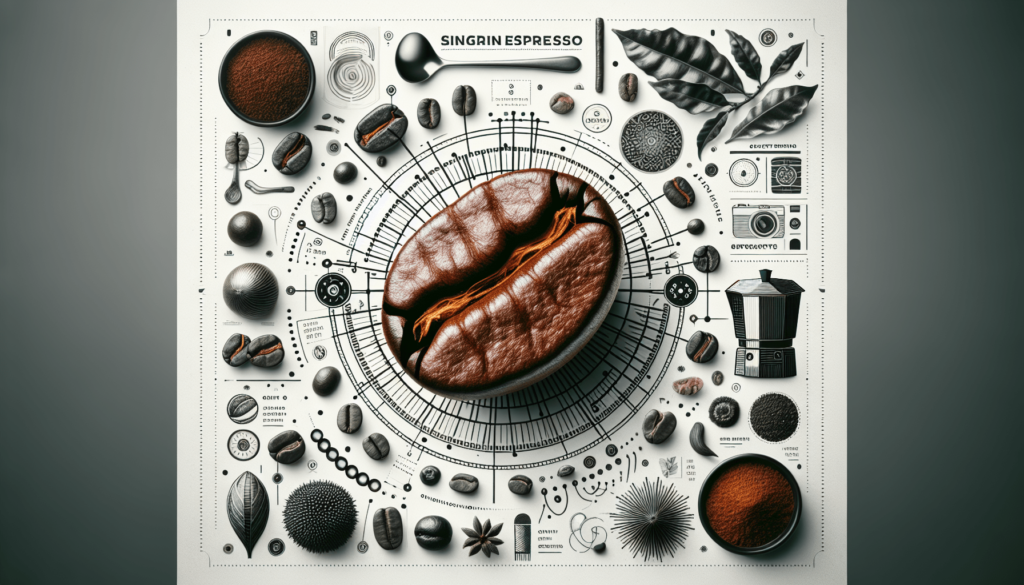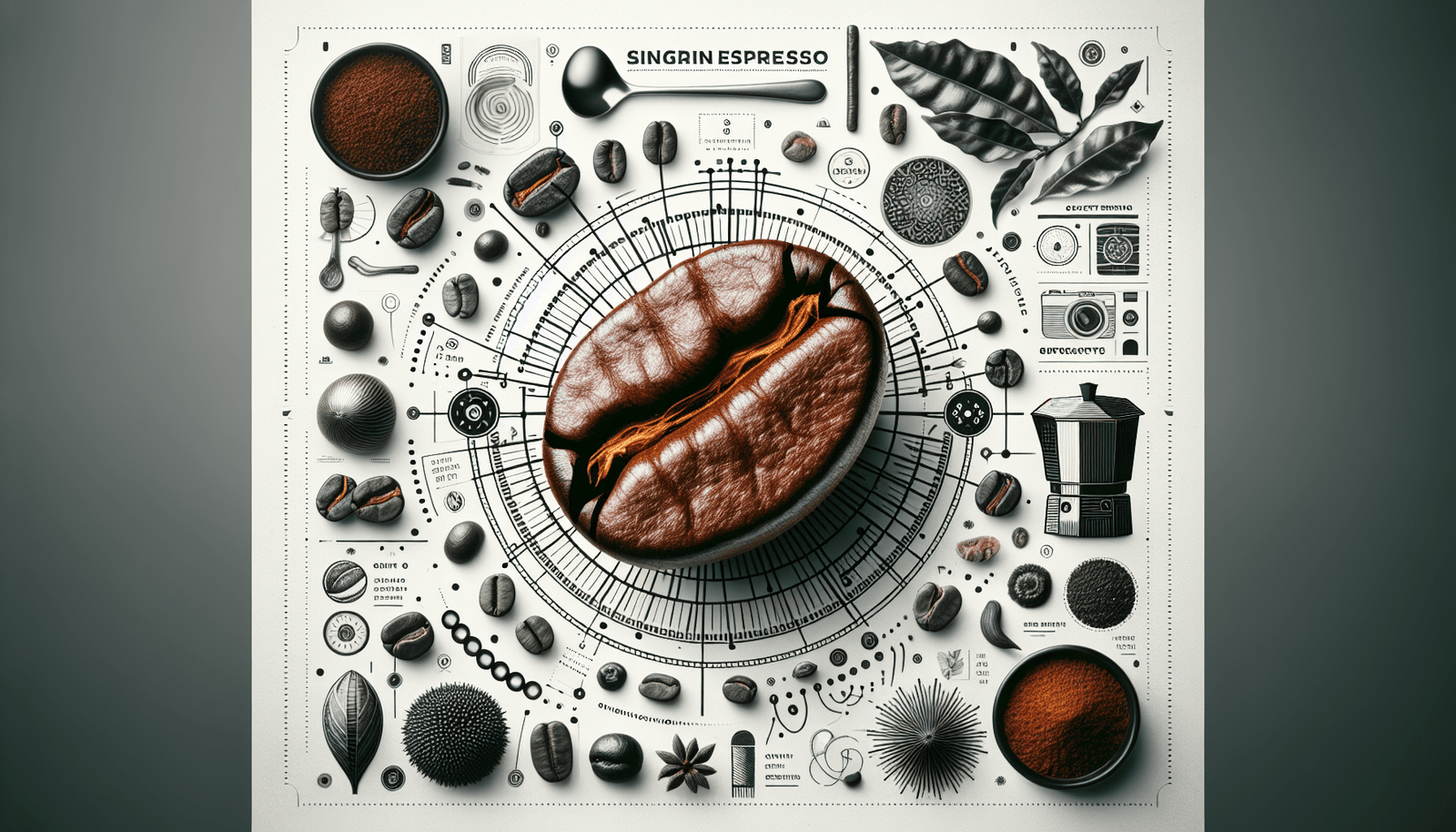In this article, you will embark on a delightful journey of discovering the world of single-origin espresso beans. Get ready to indulge your taste buds and explore the unique characteristics that set these beans apart. From the vibrant notes of Kenyan beans to the creamy richness of Colombian ones, you will learn about the diverse flavors that can be experienced through this single-origin approach. So, grab your cup and join us as we delve into the fascinating world of single-origin espresso beans!

1. What are single-origin espresso beans?
Definition of single-origin espresso beans
Single-origin espresso beans are coffee beans that come from a single farm, region, or country. Unlike blended coffee, where beans from multiple origins are mixed together, single-origin espresso beans offer a unique taste experience that showcases the distinct characteristics of a specific origin. This focus on origin allows coffee lovers to appreciate the flavors, aromas, and nuances that are specific to a particular region’s soil, climate, and cultivation methods.
Why they are considered special in the coffee world
Single-origin espresso beans are considered special in the coffee world because they offer a level of transparency and traceability that is often lacking in blended coffees. By knowing exactly where the beans come from, consumers can better understand the coffee’s story, including the farmers who grew it and the unique conditions in which it was cultivated. This knowledge allows coffee enthusiasts to appreciate the craftsmanship and hard work that goes into producing high-quality single-origin espresso beans.
2. Benefits of using single-origin espresso beans
Enhanced flavor profile
One of the major benefits of using single-origin espresso beans is their enhanced flavor profile. Since these beans are not blended with others, they maintain their distinct flavors, which can range from fruity and floral to nutty and chocolatey. Single-origin espresso beans allow you to truly taste the nuances and complexities that are specific to a particular region, providing a richer and more satisfying coffee experience.
Traceability and transparency
Single-origin espresso beans offer a level of traceability and transparency that is highly valued by coffee enthusiasts. With blended coffees, it can be difficult to know exactly where the beans come from and how they were sourced. However, with single-origin beans, you can trace the coffee back to its origin, learn about the farming practices used, and even support local farmers directly. This transparency ensures that the coffee you are enjoying is ethically sourced and produced.
Supporting local farmers and communities
By choosing single-origin espresso beans, you are not only getting a delicious cup of coffee but also actively supporting local farmers and communities. When you purchase these beans, you are directly contributing to the economic sustainability of small-scale coffee producers. This helps create a more equitable and fair coffee industry, where farmers receive fair compensation for their hard work, ensuring the future viability of coffee farming communities.
3. Popular single-origin espresso beans
Ethiopian Sidamo
Ethiopian Sidamo coffee beans are renowned for their delicate and complex flavor profile. They often exhibit notes of blueberry and chocolate, with a floral aroma that is distinctive to the region. These beans are grown in the Sidamo region of Ethiopia, known for its high altitude and fertile soil, which contributes to the exceptional quality of the coffee.
Colombian Supremo
Colombian Supremo beans are highly regarded for their balanced flavor profile. They offer a combination of nutty and chocolatey notes, with a pleasant acidity that adds brightness to the cup. These beans are grown in the mountains of Colombia, where the cool temperatures and high altitude create the perfect conditions for cultivating exceptional coffee.
Brazilian Santos
Brazilian Santos beans are known for their low acidity and smooth flavor profile. They often have nutty undertones and a hint of sweetness, often described as caramel-like. These beans are grown in the Santos region of Brazil, where the tropical climate and rich soil provide optimal conditions for coffee cultivation. Brazilian Santos beans are widely used in espresso blends for their versatility and consistent quality.
Guatemalan Antigua
Guatemalan Antigua beans are cherished for their unique flavor profile, which combines smoky, floral, and chocolatey notes. These beans are grown in the Antigua region of Guatemala, which is surrounded by volcanoes, providing a rich volcanic soil that imparts distinct characteristics to the coffee. The altitude and microclimate of the region further contribute to the complex flavors found in Guatemalan Antigua beans.
Costa Rican Tarrazu
Costa Rican Tarrazu beans are prized for their bright acidity and vibrant flavors. They often exhibit citrus notes, along with hints of honey and sweetness. These beans are grown in the Tarrazu region of Costa Rica, which is known for its high-altitude farms and rich volcanic soil. The meticulous cultivation and processing methods used in Tarrazu result in coffee beans of exceptional quality and flavor.
4. Flavor profiles of different single-origin espresso beans
Ethiopian Sidamo – notes of blueberry and chocolate
Ethiopian Sidamo beans are celebrated for their unique flavor profile, which often includes prominent notes of blueberry and chocolate. These beans have a subtle sweetness accompanied by a floral aroma, making them a favorite among coffee enthusiasts who enjoy a complex and fruit-forward cup of espresso.
Colombian Supremo – balanced, nutty, and chocolatey
Colombian Supremo beans offer a balanced and crowd-pleasing flavor profile. They are often described as having a medium body with nutty undertones and chocolatey notes. This combination creates a well-rounded cup of espresso that is enjoyed by many for its comforting and familiar taste.
Brazilian Santos – low acidity, nutty, and caramel notes
Brazilian Santos beans are known for their low acidity and smooth flavor profile. They often exhibit nutty characteristics, with hints of caramel. This combination of flavors creates a mellow and approachable cup of espresso that is enjoyed by those who prefer a more subtle and gentle taste.
Guatemalan Antigua – smoky, floral, and chocolatey
Guatemalan Antigua beans offer a unique flavor profile that combines smoky, floral, and chocolatey notes. This combination creates a complex and intriguing cup of espresso that is often described as sophisticated. The smoky undertones add depth to the flavor, while the floral and chocolatey notes provide a pleasant balance.
Costa Rican Tarrazu – bright acidity, citrus, and honey
Costa Rican Tarrazu beans are known for their bright acidity and vibrant flavors. They often exhibit citrus notes, with hints of honey and sweetness. This combination of flavors creates a refreshing and invigorating cup of espresso that is enjoyed by those who appreciate a lively and bright taste experience.

5. Factors to consider when choosing single-origin espresso beans
Origin and terroir
The origin and terroir of single-origin espresso beans play a significant role in determining their flavor profile. Different regions have unique climate, altitude, and soil conditions, which influence the characteristics of the coffee. Consider exploring beans from various origins to experience the diverse flavor profiles that each region has to offer.
Roast level
The roast level of single-origin espresso beans can greatly impact their taste. Lighter roasts tend to preserve the delicate and nuanced flavors of the beans, while darker roasts bring out bolder and smokier notes. Experiment with different roast levels to find the perfect balance that suits your taste preferences.
Processing method
The processing method used for single-origin espresso beans can contribute to their flavor profile. Different processing methods, such as natural, washed, or honey processing, result in distinct taste characteristics. Each method brings out unique flavors and aromas, so consider exploring beans that have been processed using different methods to broaden your coffee experience.
Freshness
Freshness is crucial when it comes to coffee, as it greatly affects the overall taste and quality. Look for single-origin espresso beans that have been recently roasted to ensure optimal freshness. Coffee beans are at their peak flavor within a few weeks of the roast date, so choose beans that have been packaged with this timeline in mind.
Personal taste preferences
Ultimately, personal taste preferences should guide your choice of single-origin espresso beans. Consider the flavors you enjoy and the characteristics you seek in your coffee. Do you prefer a bright and citrusy cup? Or perhaps you gravitate towards a more chocolatey and nutty profile? Understanding your own preferences will help you select single-origin espresso beans that align with your taste preferences.
6. Brewing methods for single-origin espresso beans
Espresso machine
Using an espresso machine is a popular method for brewing single-origin espresso beans. The machine applies pressure to extract the flavors from the finely ground coffee, resulting in a rich and concentrated cup of espresso. This method allows you to fully experience the unique flavors and aromas of single-origin beans.
Moka pot
The Moka pot is another method for brewing single-origin espresso beans that is widely used. It utilizes steam pressure to force water through the coffee grounds, producing a strong and flavorful cup of espresso. While it may not provide the same crema as an espresso machine, the Moka pot is a great alternative for enjoying single-origin beans at home.
Aeropress
The Aeropress is a versatile and user-friendly brewing method that can produce a smooth and clean cup of espresso. It uses air pressure to extract the flavors from the coffee grounds and has the advantage of being portable, making it an excellent option for coffee enthusiasts on the go.
French press
While typically associated with brewing regular coffee, the French press can also be used to brew single-origin espresso beans. This method allows for a full immersion brewing process, resulting in a robust and full-bodied cup of coffee. The French press can be a great choice for those who enjoy a richer and more intense espresso experience.
7. Single-origin espresso beans vs. blends
Differences in flavor complexity and consistency
One of the main differences between single-origin espresso beans and blends is the flavor complexity and consistency. Single-origin beans offer a unique taste experience, showcasing the distinct flavors and characteristics of a specific origin. On the other hand, blends are designed to create a consistent flavor profile by combining beans from different origins, resulting in a more balanced and uniform taste.
Advantages and disadvantages of each
Single-origin espresso beans have the advantage of providing a deeper exploration of a specific region’s coffee flavors. They allow for an appreciation of the subtleties and nuances that are unique to a particular origin. This can be exciting for those who enjoy diversity and complexity in their coffee. However, single-origin beans may also be less forgiving if the brewing process or equipment is not optimized, as they can be more sensitive to variables such as water temperature and extraction time.
Blends, on the other hand, offer a more consistent and reliable flavor profile. They are often carefully crafted to provide a balanced and harmonious taste experience, regardless of slight variations in brewing parameters. Blends can be a good choice for those who prefer a reliably enjoyable cup of coffee without the need for extensive experimentation. However, blends may lack the distinct characteristics and unique flavors that single-origin beans offer.
Ultimately, the choice between single-origin espresso beans and blends comes down to personal preference. Some coffee lovers enjoy the adventure and exploration offered by single-origin beans, while others value the consistency and accessibility of blends.
8. Buying and storing single-origin espresso beans
Considerations when purchasing
When purchasing single-origin espresso beans, there are several considerations to keep in mind. First, ensure that the beans are freshly roasted and within the optimal timeframe after the roast date. Look for reputable roasters who prioritize the quality and traceability of their beans. Additionally, take into account your personal taste preferences and the flavor profiles associated with the specific origin of the beans.
Proper storage techniques
To maintain the freshness and flavor of single-origin espresso beans, proper storage techniques are essential. It is best to store the beans in an airtight container, away from light, heat, and moisture. Avoid storing the beans in the refrigerator or freezer, as the moisture and temperature fluctuations can negatively impact the quality. Ideally, consume the beans within 2-4 weeks of the roast date to experience them at their best.
9. Popular brands offering single-origin espresso beans
Intelligentsia Coffee
Intelligentsia Coffee is a renowned specialty coffee roaster that offers a wide range of single-origin espresso beans. They prioritize direct trade relationships with farmers, ensuring the highest quality and sustainability. Their beans are carefully roasted to highlight the unique flavors of each origin, providing a memorable coffee experience.
Blue Bottle Coffee
Blue Bottle Coffee is known for its commitment to sourcing high-quality, single-origin espresso beans. They work directly with farmers and emphasize freshness, roasting their beans to order. With a focus on transparency and sustainability, Blue Bottle Coffee offers a diverse lineup of single-origin beans, allowing customers to explore different flavors from around the world.
Stumptown Coffee Roasters
Stumptown Coffee Roasters is a popular coffee brand that specializes in single-origin espresso beans. They prioritize relationships with farmers and only source beans that meet their rigorous quality standards. With a commitment to sustainability and environmental stewardship, Stumptown offers a range of distinct and flavorful options for coffee enthusiasts.
Counter Culture Coffee
Counter Culture Coffee is a specialty coffee roaster known for its selection of single-origin espresso beans. They work directly with farmers and cooperatives to ensure transparency and fair trade practices. Counter Culture Coffee offers a variety of origins and flavor profiles, showcasing the diversity of the coffee world.
Four Barrel Coffee
Four Barrel Coffee is a beloved coffee roaster that offers single-origin espresso beans sourced from around the world. They focus on sustainable relationships with farmers and hand-select their beans for exceptional quality. With an emphasis on craftsmanship and flavor, Four Barrel Coffee provides a range of delicious options for those seeking the finest single-origin espresso beans.
10. Exploring and experiencing single-origin espresso beans
Visiting local coffee shops and specialty cafes
Visiting local coffee shops and specialty cafes is a wonderful way to explore and experience single-origin espresso beans. These establishments often curate a rotating selection of beans from different origins, allowing you to taste and compare the flavors and profiles. Baristas at these cafes are often knowledgeable and passionate about coffee, and they can provide insights and recommendations based on your taste preferences.
Attending tasting events and cuppings
Tasting events and cuppings provide an opportunity to sample and compare different single-origin espresso beans side by side. These events are often hosted by coffee professionals or specialty coffee roasters and offer a guided exploration of different origins and flavor profiles. Attending these events can deepen your understanding and appreciation of the diverse world of single-origin espresso beans.
Experimenting with different brewing methods
Experimenting with different brewing methods is a fun and engaging way to explore the flavors and characteristics of single-origin espresso beans. Each brewing method offers a unique extraction process, which can bring out different aspects of the coffee’s flavor profile. By trying out different techniques, such as the espresso machine, Moka pot, Aeropress, or French press, you can discover new dimensions of your favorite beans.
Creating your own signature espresso blend
For those who enjoy a more hands-on approach to their coffee experience, creating a signature espresso blend can be an exciting endeavor. By combining different single-origin beans in various ratios, you can create a blend that suits your taste preferences and brings together the best qualities of each origin. This experimentation allows for a personalized and customized espresso experience that is uniquely yours.
In conclusion, exploring different single-origin espresso beans offers a myriad of flavors, aromas, and experiences. From the delicate and fruity Ethiopian Sidamo to the rich and smoky Guatemalan Antigua, each origin has its own story to tell through coffee. By understanding the benefits, considering factors when choosing beans, and experimenting with brewing methods, you can embark on a flavorful journey that celebrates the diverse world of single-origin espresso beans. So go ahead, indulge in the distinct taste profiles and support local farmers while you savor every sip of your favorite single-origin espresso.

